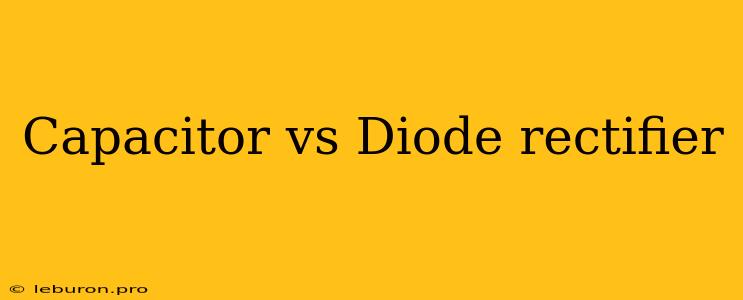Capacitors and diode rectifiers are fundamental components in electronics, each playing a crucial role in shaping and manipulating electrical signals. While they may appear distinct, their functionalities often intertwine, particularly in power supply circuits where the conversion of alternating current (AC) to direct current (DC) is essential. Understanding the differences and similarities between capacitors and diode rectifiers is vital for comprehending how these components contribute to circuit performance and functionality.
Capacitor vs Diode Rectifier: Understanding the Differences
Capacitors and diode rectifiers are both passive electronic components, meaning they do not amplify or generate electrical signals but rather act as circuit elements that modify and control the flow of current. However, their fundamental principles of operation differ significantly:
Capacitors:
- Function: Capacitors store electrical energy in an electric field created between two conductive plates separated by a non-conductive material called a dielectric.
- Behavior: When a voltage is applied across a capacitor, it accumulates an electric charge proportional to the voltage. This stored charge can be released back into the circuit when the voltage is removed or reversed.
- Applications: Capacitors are widely used in various applications, including:
- Filtering: Smoothing out voltage fluctuations in power supplies and signal circuits.
- Timing: Creating time delays in circuits for applications like oscillators and timers.
- Energy storage: Serving as temporary energy reservoirs in power systems.
- Coupling: Transferring AC signals between circuit stages without allowing DC current to flow.
Diode Rectifiers:
- Function: Diode rectifiers are semiconductor devices that allow current to flow in only one direction.
- Behavior: A diode rectifier has a forward bias and a reverse bias. In forward bias, when the positive terminal of the voltage source is connected to the anode and the negative terminal to the cathode, current flows easily through the diode. In reverse bias, when the polarity is reversed, the diode blocks the current flow.
- Applications: Diode rectifiers are primarily used for:
- Rectification: Converting AC to DC by allowing only half of the AC waveform to pass through.
- Voltage regulation: Maintaining a relatively stable DC output voltage from an AC source.
- Protection: Preventing reverse current flow in circuits and protecting sensitive components.
The Synergy of Capacitors and Diode Rectifiers
While capacitors and diode rectifiers operate on different principles, they often collaborate in power supply circuits to achieve specific functionalities. A common example is a capacitor-input filter used in DC power supplies. This filter consists of a diode rectifier followed by a capacitor. Here's how they work together:
- Diode Rectification: The diode rectifier converts the incoming AC voltage into a pulsating DC voltage. This waveform has a ripple, meaning it oscillates around a DC average value.
- Capacitor Smoothing: The capacitor connected to the output of the rectifier acts as a filter. During the positive half-cycle of the AC waveform, the capacitor charges up to the peak voltage. During the negative half-cycle, the diode blocks current, and the capacitor discharges slowly, providing a smoother DC output.
Conclusion
Capacitors and diode rectifiers are essential components in electronics, each contributing uniquely to circuit performance. While their functions differ, they often complement each other, particularly in power supply circuits. Understanding the roles of these components is vital for building and troubleshooting electronic circuits. By harnessing the abilities of both capacitors and diode rectifiers, engineers can design efficient and reliable power systems that meet various electronic demands. The combination of these components allows for the conversion and filtering of AC to DC, essential for powering a wide range of devices and systems.
